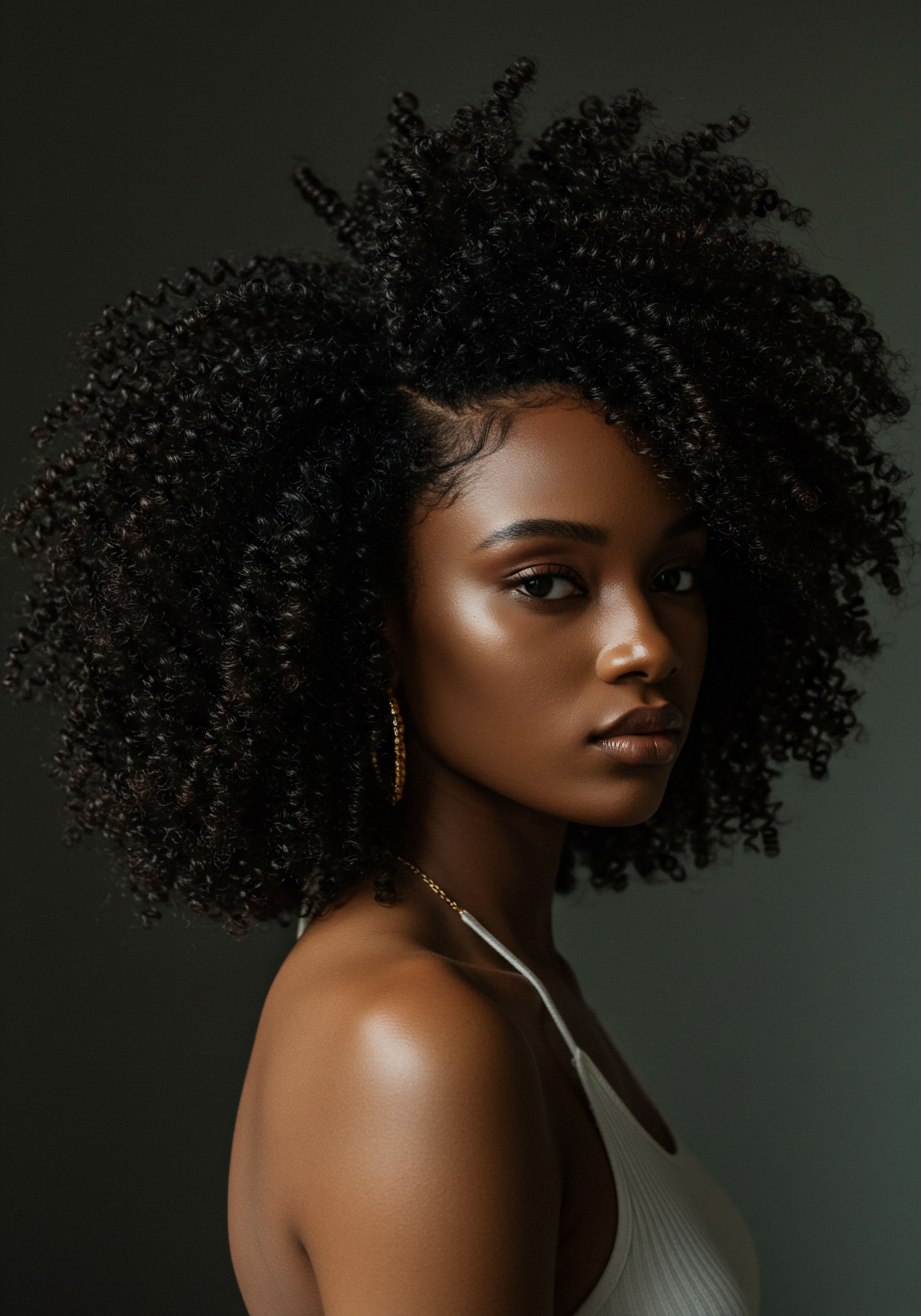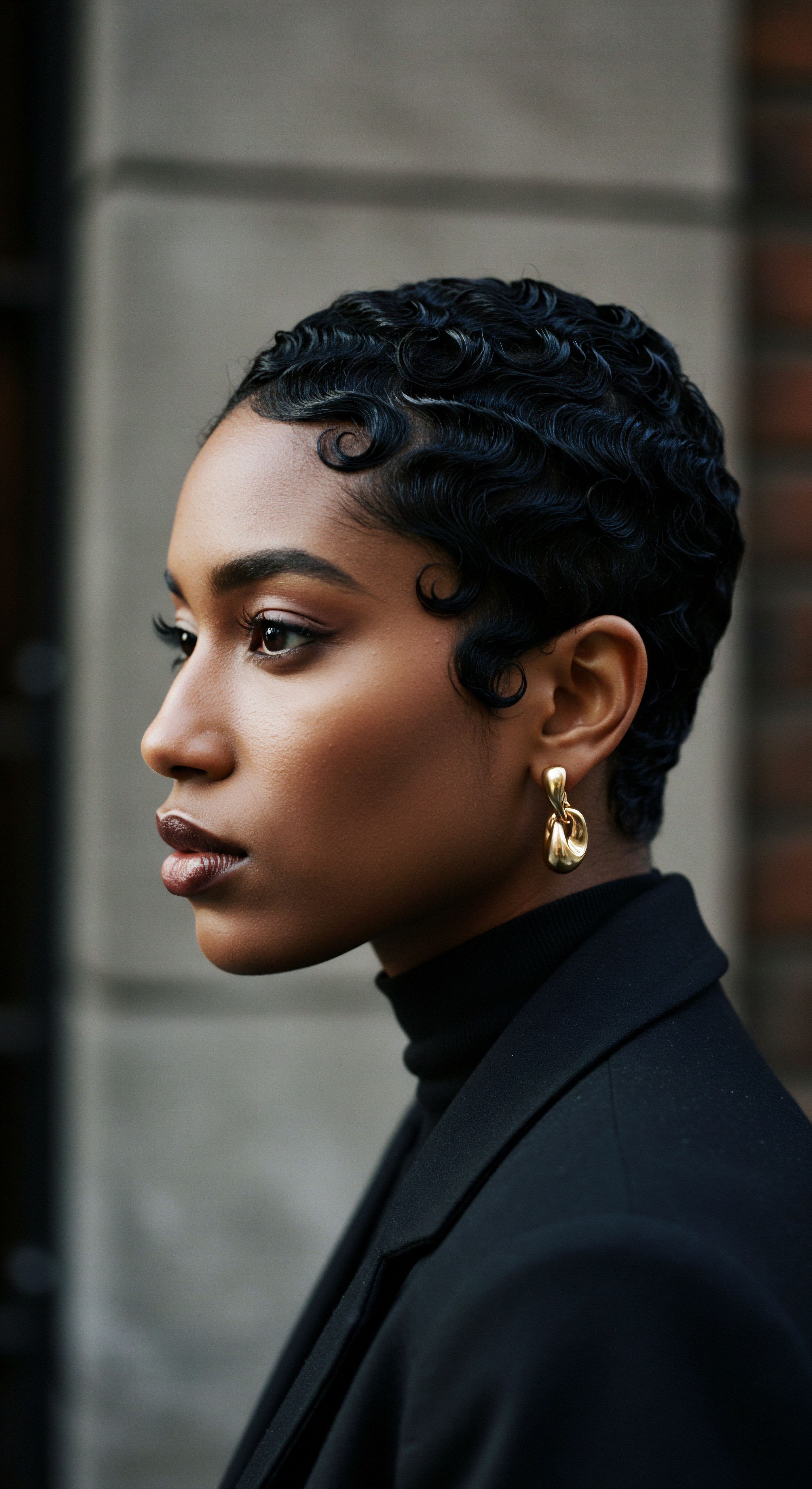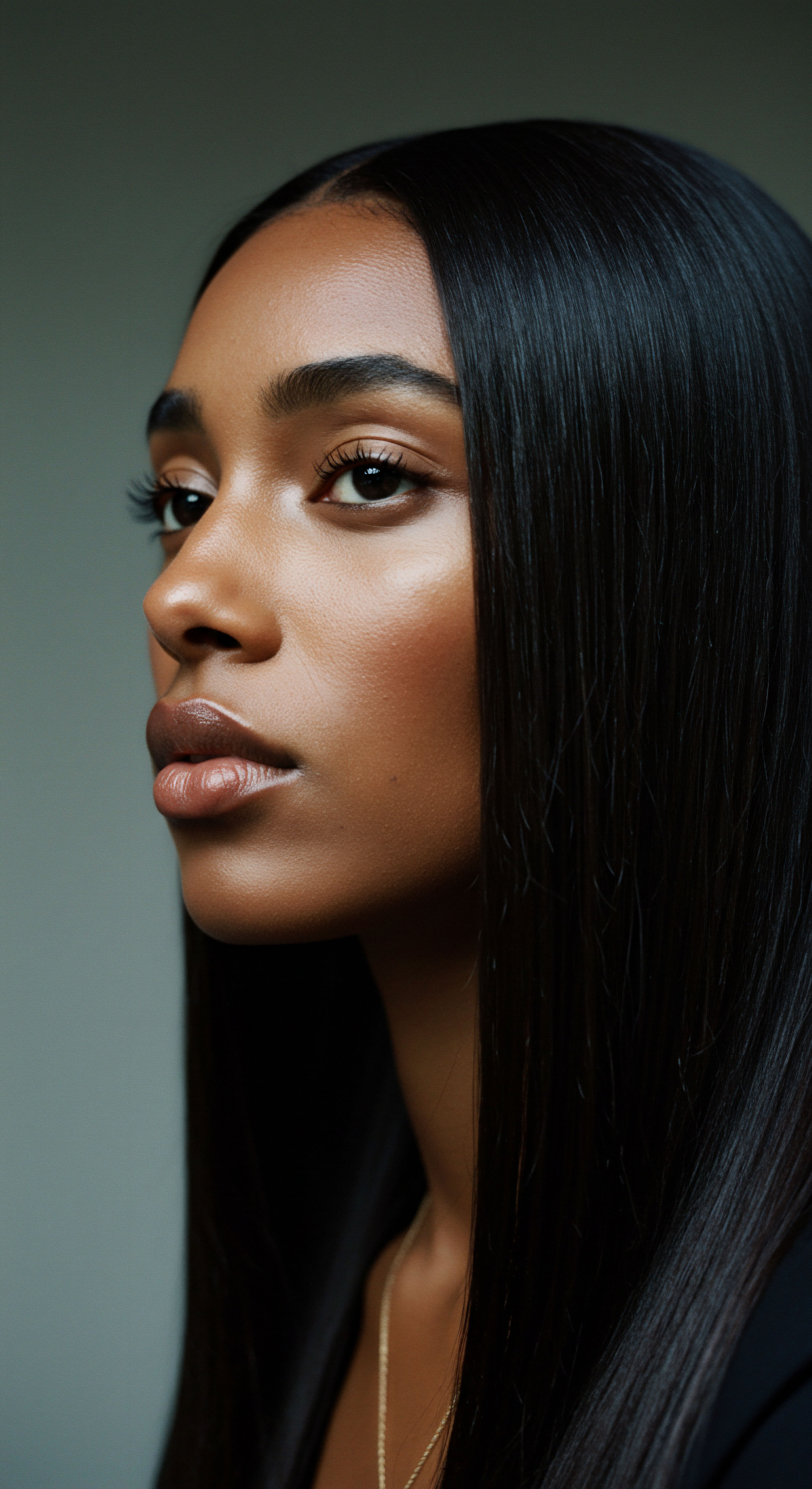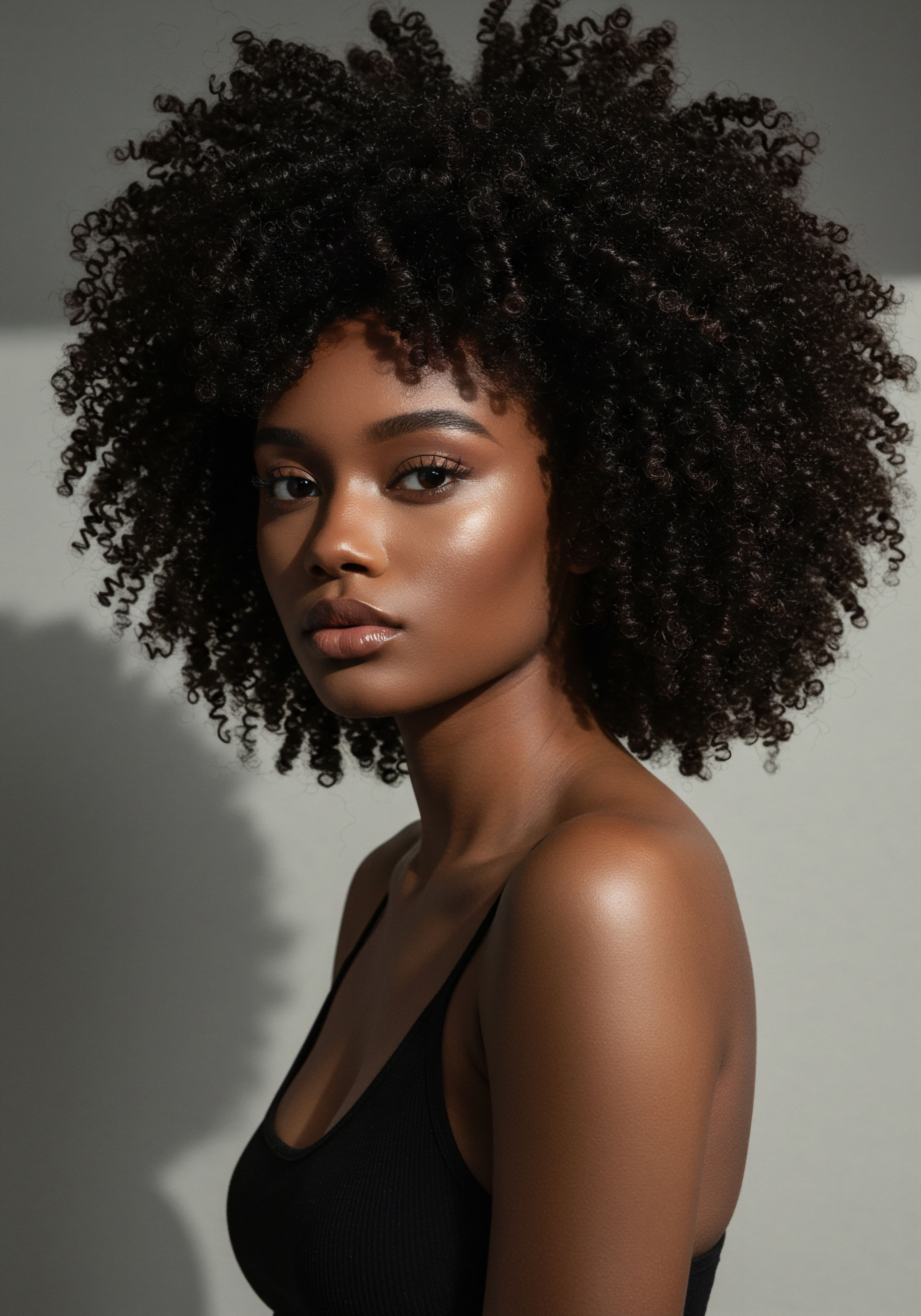
Roots
The quiet hum of the world as it settles into slumber, the gentle sigh of the wind outside a window, the hushed moments before dawn—these periods of stillness hold a subtle yet profound power. It is in these restful intervals, often overlooked in our bustling modern lives, that traditional wisdom across diverse cultures has long perceived a deep connection to the vitality of our hair. This understanding extends beyond mere aesthetics, reaching into the very core of well-being, where hair health becomes a mirror reflecting the body’s inner equilibrium.
Across continents and through centuries, communities have observed that the strength, sheen, and very presence of hair seem inextricably linked to states of rest and peace. This is not a mere coincidence or a quaint folk belief; rather, it represents an intuitive grasp of physiological processes, long before the advent of modern scientific tools. The ancients understood that the body, like the earth, requires periods of dormancy to replenish its reserves, and that every aspect of our physical being, down to the delicate strands upon our heads, benefits from this renewal.

The Circadian Dance of Hair Follicles
At the very foundation of hair health lies the intricate biological rhythm governing our bodies, known as the circadian clock. This internal timekeeper orchestrates countless physiological processes over a roughly 24-hour cycle, influencing everything from sleep patterns to hormone release. Remarkably, hair follicles themselves possess their own localized circadian clocks, a fascinating revelation from recent scientific inquiry. These follicular clocks regulate the precise timing of cell division and activity within the hair growth cycle.
Research has revealed that certain Clock Genes, like CLOCK and BMAL1, are highly active within hair follicles, particularly during the growth phase, known as anagen. A study from 2013, published in the journal PNAS, demonstrated that these peripheral circadian clocks in epithelial matrix cells generate a prominent daily mitotic rhythm, leading to hair growing faster in the morning than in the evening. This biological cadence underscores why periods of consistent rest are not simply beneficial, but rather essential for the synchronized and robust proliferation of hair cells. When these internal rhythms are disrupted, the delicate balance of the hair cycle can falter, potentially leading to compromised hair quality or even loss.

Ancient Insights into Body’s Rhythms
Long before laboratory studies could pinpoint specific genes or cellular activities, traditional healing systems held an understanding of the body’s natural rhythms and their impact on vitality. In Ayurvedic medicine, for instance, hair is considered a by-product of bone tissue and deeply connected to the body’s digestive fire, or ‘agni’. A robust agni and a balanced state of the doshas (Vata, Pitta, and Kapha) are seen as crucial for healthy hair.
Establishing a consistent sleep routine, particularly aiming for bedtime around 10 PM, aligns with Ayurvedic principles, as the liver, a ‘Pitta organ’, performs its detoxification functions most effectively before midnight. This suggests an ancient recognition of how internal cleansing and systemic balance, supported by timely rest, contribute to overall physical manifestations, including the vibrancy of hair.
Traditional wisdom across cultures intuitively understood that rest periods are not mere pauses but active phases of cellular renewal, deeply connected to hair’s vitality.
Similarly, Traditional Chinese Medicine (TCM) views hair health as intimately connected to the balance of vital energy, known as ‘Qi’, the quality of blood, and the functioning of internal organs, especially the Kidneys. The TCM ‘Organ Body Clock’ illustrates how Qi circulates through different organ systems in two-hour intervals over a 24-hour period. During sleep, Qi draws inward to restore the body, with the liver cleansing the blood between 1 AM and 3 AM.
A consistent sleep schedule, therefore, supports the body’s ability to cleanse and regenerate, directly influencing the nourishment available to hair follicles. Disrupted sleep patterns, from this perspective, lead to imbalances that can manifest as weakened or thinning hair.
The emphasis on restful periods in these ancient systems was not simply about physical inactivity. It was about allowing the body’s intrinsic restorative mechanisms to perform their vital work, ensuring that the foundational elements supporting hair growth were replenished and regulated.

Ritual
As we move from the foundational understanding of rest to its practical manifestations, we encounter the rich tapestry of rituals that diverse cultures have woven around nighttime and hair care. These practices, passed down through generations, speak to a deep, experiential knowledge of how deliberate periods of calm and specific nighttime routines contribute to the strength and luster of strands. They are not merely acts of beautification; they are ceremonies of self-care, acknowledging the body’s need for tranquility to mend and renew.
Consider the widespread practice of hair oiling, particularly prominent in South Asian cultures. This time-honored ritual, with roots in Ayurvedic practices dating back 4000-5000 years, involves warming herbal oils and massaging them into the scalp and hair, often left on for several hours or overnight. The oil is believed to nourish and strengthen hair, improve blood circulation to the scalp, and importantly, promote relaxation and stress relief. The act of gentle massage before sleep, combined with the nourishing properties of the oils, prepares the scalp and hair for a period of profound rest.

Nighttime Hair Practices Across Continents
The wisdom of protecting hair during sleep is also evident in the practices of African and African diaspora communities. For individuals with textured hair, nightly care is not an optional luxury but a necessary shield against friction, dryness, and breakage that can occur against absorbent pillowcases. This includes moisturizing the hair, styling it in protective ways, and covering it with silk pillowcases or satin bonnets.
- Pineappling ❉ A method where hair is gathered loosely at the very top of the head, creating a high, loose ponytail or bun. This protects the curl pattern from being flattened or distorted while sleeping and minimizes friction against the pillow.
- Twisting and Braiding ❉ Dividing hair into sections and creating loose twists or braids before bed helps prevent tangling, matting, and breakage, especially for coily or kinky textures.
- Satin Bonnets and Silk Pillowcases ❉ The smooth surface of satin or silk reduces friction on hair strands, preventing breakage and frizz, and importantly, helps hair retain its natural moisture, unlike cotton which can absorb oils.
These nighttime protective styles and accessories are not merely about preserving a hairstyle; they are about creating a sanctuary for hair during its most vulnerable state. The reduction of physical stress on the hair shaft during sleep allows the scalp and follicles to rest undisturbed, supporting natural regenerative processes.

The Role of Scalp Massage in Restful Regeneration
Beyond cultural traditions, scientific understanding has begun to illuminate the physiological benefits of practices long held sacred. Scalp massage, often a component of pre-sleep hair rituals in many cultures, is now recognized for its direct impact on hair health and its indirect influence through promoting rest. A small 2016 study, published in the Journal of Physical Therapy Science, found that daily 4-minute scalp massages over 24 weeks led to increased hair thickness in participants.
This benefit extends beyond direct physical stimulation. Scalp massages can significantly lower stress hormones like cortisol, which are known to disrupt hair cycles and contribute to conditions such as telogen effluvium, a type of hair loss linked to excessive shedding following stress. By reducing stress and promoting relaxation, scalp massage helps induce a state conducive to deeper, more restorative sleep.
Studies show that a 15-minute scalp massage can reduce stress hormone levels, heart rate, and blood pressure, simultaneously improving sleep quality. This interplay underscores a key aspect of traditional wisdom ❉ physical practices that induce calm are intrinsically tied to biological benefits, including those affecting hair.
Nighttime rituals, from oiling to protective styling, reflect a universal understanding that undisturbed rest is crucial for hair’s rejuvenation and resilience.
The calming effect of a nightly scalp massage, perhaps with a traditional oil like Bhringaraj in Ayurveda, which is known for its cooling properties and ability to calm Vata and Pitta doshas, directly influences the quality of sleep. Better sleep, in turn, supports the body’s natural regenerative processes, including those within the hair follicles.
| Cultural Origin South Asia (Ayurveda) |
| Ritual Hair Oiling with Herbal Oils |
| Associated Benefits for Hair and Rest Nourishes and strengthens hair, improves scalp circulation, promotes relaxation and stress relief, aids in deeper sleep. |
| Cultural Origin African Diaspora |
| Ritual Protective Styling (Pineappling, Twists, Braids) |
| Associated Benefits for Hair and Rest Minimizes friction and breakage, preserves moisture, maintains curl pattern, allows scalp to rest undisturbed. |
| Cultural Origin Traditional Chinese Medicine |
| Ritual Nightly Hair Combing, Scalp Massage |
| Associated Benefits for Hair and Rest Stimulates blood and energy circulation (Qi), provides nutrients to roots, helps clear energy from the mind, reduces stress, improves sleep quality. |
| Cultural Origin Global Traditional Wisdom |
| Ritual Sleeping on Silk/Satin |
| Associated Benefits for Hair and Rest Reduces friction, prevents breakage and frizz, helps hair retain moisture. |
| Cultural Origin These rituals, whether simple or elaborate, highlight a shared understanding of rest's profound influence on hair vitality. |
These practices are not just about what is applied to the hair, but the mindful state cultivated before sleep. They underscore a holistic perspective where the tranquility of the mind and body directly translates to the health and beauty of hair.

Relay
To consider the profound link between restful periods and hair vitality requires a deeper investigation, moving beyond surface observations into the complex interplay of biological mechanisms, cultural beliefs, and environmental factors. This connection is not merely anecdotal; it is substantiated by a growing body of scientific inquiry that validates the wisdom of ancient practices, revealing how sleep acts as a crucial regulatory period for hair health at a cellular and systemic level.
The human body’s restorative processes are profoundly active during sleep. This is when essential growth hormones, including those that promote hair growth, are released. Moreover, sleep plays a critical role in balancing hormone levels, such as melatonin, estrogen, and testosterone, all of which influence the hair cycle. Disruptions in these hormonal balances, often a direct consequence of inadequate rest, can lead to thinning or breakage.

How Sleep Influences Hair Follicle Cycles?
The hair growth cycle consists of three main phases ❉ anagen (active growth), catagen (transition), and telogen (resting). Quality sleep directly supports the anagen phase, where hair follicles produce new hair. During deep sleep, cell turnover increases, and tissue repair takes place, supporting this active growth.
One particularly compelling piece of research involves the hormone melatonin. Melatonin, primarily known for regulating sleep, also appears to directly influence hair growth. A 2022 study, using lab models of human hair follicles, found that dermal papillae cells, which are critical for hair growth signals, possess higher levels of melatonin receptors.
The study concluded that melatonin binding to these receptors may promote hair growth, with the addition of melatonin boosting the expression of genes associated with hair growth. This finding was supported by a 2024 mouse study, which indicated that melatonin accelerated the hair cycle.
This research lends significant weight to the traditional understanding that restful nights, during which melatonin production peaks, contribute to hair’s vitality. The pineal gland, which produces melatonin, operates in sync with light and darkness, making consistent sleep patterns essential for its optimal release.
Modern science confirms what ancient cultures sensed ❉ sleep is a period of intense biological activity for hair, driven by hormonal rhythms and cellular repair.
Furthermore, sleep deprivation is a physiological stressor that elevates cortisol levels. Chronic high cortisol can prematurely push hair follicles into the telogen (resting) phase, leading to excessive shedding, a condition known as telogen effluvium. A 2022 study highlighted a strong link between severe alopecia areata, an autoimmune hair loss condition, and sleep issues, including less than six hours of sleep and high stress scores. This demonstrates a direct, research-backed link between inadequate rest, systemic stress, and hair loss, validating the warnings embedded in traditional wisdom.

Beyond Biology ❉ The Cultural Dimension of Hair and Rest
The understanding of rest and hair health in diverse cultures extends beyond purely biological observations, encompassing psychological and social dimensions. In many traditional societies, hair is not just a biological appendage; it carries deep symbolic meaning related to identity, status, spirituality, and well-being. Therefore, caring for hair, particularly during vulnerable periods like sleep, becomes a ritualistic act of self-preservation and cultural continuity.
For example, in some Indigenous American traditions, hair is considered a sacred extension of one’s spirit and thoughts. The practice of tending to hair, often involving gentle combing and the application of natural oils before sleep, is not just about physical health but about maintaining spiritual and mental clarity. Disruptions to rest or neglect of hair care could be seen as a disruption to one’s overall energetic balance.
Similarly, the communal aspect of nighttime hair rituals, as seen in some South Asian families where mothers and daughters share hair oiling sessions, reinforces social bonds while transmitting knowledge about self-care. These shared moments, often accompanied by storytelling, transform a simple act into a powerful cultural practice that contributes to both physical and emotional well-being, directly influencing stress levels and, by extension, hair health.
The significance of the “night” in these cultural contexts often carries spiritual connotations, as a time for introspection, connection to ancestors, or divine energy. Protecting hair during this period is a way of honoring oneself and one’s heritage, reflecting a holistic view where the physical body is deeply intertwined with the spiritual and social self.
The interplay between biological reality and cultural interpretation creates a powerful framework for understanding why restful periods are so deeply linked to hair vitality. It is a testament to the enduring wisdom that recognizes the body as an interconnected system, where the seemingly simple act of resting profoundly impacts the complex biology of hair growth and overall well-being.
- Melatonin Production ❉ This hormone, crucial for sleep regulation, has been shown to directly stimulate hair growth by influencing hair follicle cells.
- Cortisol Regulation ❉ Adequate sleep helps regulate stress hormones like cortisol, whose elevated levels can trigger hair shedding.
- Cellular Repair ❉ During deep sleep, the body actively repairs and regenerates cells, including those in hair follicles, supporting their active growth phase.
- Blood Circulation ❉ Restful periods promote optimal blood flow to the scalp, ensuring hair follicles receive essential nutrients and oxygen.

Reflection
The whispers of ancient wisdom, carried through generations and echoed in the quiet practices of diverse cultures, converge with the exacting insights of modern science to illuminate a singular truth ❉ true hair vitality springs from a wellspring of rest. The lustrous strands we admire are not merely a product of topical applications or genetic predisposition; they are a living testament to the body’s profound capacity for renewal when given the gift of stillness. As we navigate the ceaseless demands of contemporary life, the gentle reminder from our ancestors—to honor the rhythms of day and night, to seek moments of deep repose—becomes not just a quaint tradition, but a profound directive for cultivating health that radiates from within, crowning us with a natural splendor.

References
- Ayurvedic texts. (2017). 7 Powerful Secrets To Achieve Exceptional Ayurvedic Hair Growth. The Ayurveda Experience Blog .
- Charaka Sutra sthana chapter 5, verse 81 and Sushruta Chikitsa sthana chapter 24, verses 25-26. (2017). The Benefits Of Ayurvedic Massage According To The Ancient Ayurvedic Texts. The Ayurveda Experience Blog .
- Moshkovich, L. (n.d.). Traditional Chinese Organ Body Clock. Nirvana Naturopathics .
- Hair Loss Clinic. (2024). Traditional Chinese Medicine (TCM) for Hair Loss ❉ How Does it Work? Hair Loss Clinic .
- Strong, P. (2020). Way To Care For African American Hair At Night. Pat Strong .
- Geyfman, M. Kumar, V. & Andersen, B. (2013). Local circadian clock gates cell cycle progression of transient amplifying cells during regenerative hair cycling. PNAS, 110(21), 8643-8648.
- Melatonin and Hair Growth. (2024). Does Melatonin Cause Hair Loss? What Research Shows. Healthline .
- Lee, H. G. et al. (2016). The effect of scalp massage on hair thickness. Journal of Physical Therapy Science, 28(9), 2701-2703.
- Saatwika Ayurveda. (2023). The Ultimate Ayurvedic Hair Care Routine for Healthy Hair. Saatwika Ayurveda .
- Lin, K. K. et al. (2010). Clock genes, hair growth and aging. Aging-US, 2(10), 656-666.
- Hair Growth Biological Clock. (2017). How Does the Circadian Rhythm Affect Hair Growth? LearnSkin .
- Pan-African. (2021). Effective Afro Hair Care Routines. Pan-African .
- Quora. (2016). What’s a basic beginning hair care regime I can follow as an African American girl? Quora .
- Ma, Z. et al. (2023). Hair Follicles as a Critical Model for Monitoring the Circadian Clock. Cells, 12(3), 485.
- Hair Care. (n.d.). African American Skin and Hair Care ❉ Tips For Non-black Parents. Hair Care .
- Plikus, M. V. et al. (2011). Circadian Clock Genes Contribute to the Regulation of Hair Follicle Cycling. PLOS Genetics, 7(5), e1002048.
- Fischer, T. W. (2009). The influence of melatonin on hair physiology. Hautarzt, 60(12), 962-972.
- HairFree & HairGrow. (2023). Sleep and Hair Loss. Relationship Explained. HairFree & HairGrow .
- Treatment Rooms London. (2024). Can A Lack of Sleep Cause Hair Loss? Treatment Rooms London .
- Traditional Chinese Medicine. (2024). Maintaining hair health with traditional Chinese medicine. Traditional Chinese Medicine .
- African Pride. (n.d.). 8 Ways to Protect Your Natural Hair at Night. African Pride .
- Advanced Hair Clinic. (n.d.). Hair Loss History & Timeline. Advanced Hair Clinic .
- Maharishi Ayurveda. (n.d.). Naturally beautiful hair with Ayurveda. Maharishi Ayurveda .
- Euphoria Beauty Bar. (2025). Crowning Glory ❉ How Scalp Massage Boosts Hair and Health. Euphoria Beauty Bar .
- AcuMedic Clinic. (2025). Hair Loss – An Introduction – Chinese & Western Medicine. AcuMedic Clinic .
- Maharshi Charak Ayurveda Clinic & Research Center. (n.d.). Ayurvedic Hair Care. Maharshi Charak Ayurveda Clinic & Research Center .
- Zhang, X. et al. (2023). Melatonin-Mediated Circadian Rhythm Signaling Exhibits Bidirectional Regulatory Effects on the State of Hair Follicle Stem Cells. Cells, 12(11), 1541.
- Two Herbs. (2023). Does Scalp Massage Help With Hair Growth? 7 Crucial Facts. Two Herbs .
- Cohen, J. (2012). 9 Bizarre Baldness Cures. History.com .
- Zhang, X. et al. (2023). Melatonin regulates the periodic growth of secondary hair follicles through the nuclear receptor RORα. Frontiers in Veterinary Science, 10, 1163456.
- Taproot Acupuncture & Herbs. (2021). Hormones, hair loss & Chinese medicine. Taproot Acupuncture & Herbs .
- Sun, J. et al. (2023). Melatonin’s Role in Hair Follicle Growth and Development ❉ A Cashmere Goat Perspective. Animals, 13(15), 2480.
- RHR LI. (n.d.). Historical Figures & Hair Loss. RHR LI .
- Pacific College of Health and Science. (2015). The Benefits of Scalp Massage for Hair Loss. Pacific College of Health and Science .
- Kimantra Spas. (n.d.). Traditional Lebanese Self-Care Rituals for Modern Life. Kimantra Spas .
- Hims. (2024). Does Lack of Sleep Cause Hair Loss? | Good Health by Hims. Hims .
- Harley Street Hair Clinic. (2024). Does Lack of Sleep Cause Hair Loss? – Harley Street Hair Clinic. Harley Street Hair Clinic .
- Hair Doctors. (2025). Can Lack of Sleep Make You Lose Hair? Uncovering the Connection. Hair Doctors .
- HHC Clinics. (n.d.). Sleep and Hair Growth – What’s the Connection? HHC Clinics .
- Brown History. (2023). The Bonding Ritual of Hair Oiling. Brown History .
- VIORI Shampoo Bars. (2022). 5 Hair Rituals From Around the Globe. VIORI Shampoo Bars .
- Listverse. (2023). 10 Things We Have Learned about Historical Figures from Hair. Listverse .
- Healthline. (n.d.). Scalp Massage for Hair Growth ❉ Does It Really Work? Healthline .
- Stenn, K. (2016). Hair ❉ A Human History. Simon & Schuster.
- Katherine Haircare. (2022). Historical Hair Care Grew My Hair to Hip Length! Here’s How. Katherine Haircare .
- Glamot. (2025). Night rituals for beautiful hair ❉ what really works and what is just marketing? Glamot .
- Joekes, C. & Pereira, A. (2021). The role of sleep in telogen effluvium and trichodynia ❉ A commentary in the context of the current pandemic. Journal of Cosmetic Dermatology, 20(11), 3465-3469.
- Joekes, C. & Pereira, A. (2024). The role of sleep in telogen effluvium and trichodynia ❉ A commentary in the context of the current pandemic. ResearchGate .